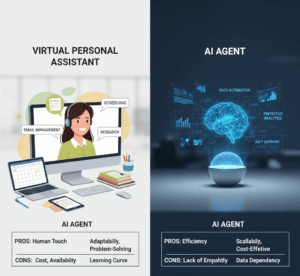Navigating the Virtual Assistant-Employer Partnership: Avoiding Common Pitfalls (2025)
From the Virtual Assistant’s Perspective
As the demand for virtual assistants (VAs) continues to rise in 2025, understanding how to foster a successful partnership between employers and VAs is crucial. Both parties play essential roles in creating a productive working relationship, but common pitfalls can hinder success. By recognising these challenges and implementing effective strategies, employers and VAs can build a harmonious partnership that enhances productivity and job satisfaction. This article outlines common mistakes from both perspectives and offers practical solutions to avoid them.
1. Undercharging for Services
Many virtual assistants struggle with pricing their services appropriately, often undercharging due to inexperience or lack of negotiation skills. This can lead to financial instability and difficulty attracting quality clients.
- Solution: VAs should research industry standards, consider their skills and experience, and set rates that reflect their value. Joining professional networks or seeking mentorship can provide insights into appropriate pricing strategies.
2. Not Setting Boundaries
Virtual assistants often face challenges in maintaining a work-life balance, which can result in burnout. Establishing clear work hours and communication preferences is crucial to managing expectations and productivity.
- Solution: VAs should communicate their availability upfront and be proactive in setting boundaries to maintain a healthy work-life balance. Using tools like shared calendars can help clarify availability to clients.
3. Neglecting Training and Onboarding
While it’s the employer’s responsibility to provide training, VAs can take the initiative by asking for clear instructions, resources, and support during the onboarding process.
- Solution: VAs should not hesitate to seek clarification on tasks or request additional training materials that will help them perform their duties effectively.
4. Failing to Communicate Effectively
Clear communication is essential for a successful working relationship. VAs should be proactive in asking questions, seeking clarification, and providing regular updates to their employers.
- Solution: Utilising project management tools and establishing preferred communication channels can help streamline communication and prevent misunderstandings.
From the Employer’s Perspective
1. Lack of Clear Roles and Responsibilities
Failing to define specific tasks and responsibilities can lead to confusion and inefficiency. Employers should provide a detailed job description outlining the VA’s duties, deadlines, and desired outcomes.
- Solution: Regular check-ins and updates can help maintain alignment and address any issues promptly while ensuring that both parties are on the same page regarding expectations.
2. Overloading with Tasks
Employers sometimes overwhelm VAs with too many tasks at once, which can decrease productivity and lead to mistakes.
- Solution: It’s important for employers to prioritise tasks and manage workloads effectively. Clear communication about priorities, deadlines, and expectations is essential for maintaining productivity.
3. Ignoring Feedback
Regular feedback is necessary for both parties to improve and adapt. Ignoring input from VAs can stifle their development and the overall effectiveness of the partnership.
- Solution: Employers should actively solicit feedback from their VAs and be open to adapting their approach based on their input. Establishing a culture of open communication fosters growth for both parties.
4. Failing to Recognise the VA’s Value
Some employers may overlook the contributions of their virtual assistants, which can lead to a lack of appreciation and motivation.
- Solution: Acknowledging a VA’s efforts fosters a better working relationship. Employers should regularly express gratitude, provide positive feedback, and consider opportunities for growth and development for their VAs.
Conclusion
In the dynamic landscape of virtual assistance, both virtual assistants and employers play crucial roles in fostering a productive and harmonious working relationship. By recognising and addressing common mistakes from both perspectives, you can enhance communication, set clear expectations, and ultimately achieve your goals more effectively. A successful partnership not only boosts productivity but also creates a positive work environment that benefits everyone involved.
Your One & Only Talent Acquisition Partner
Are you looking for assistance with additional tasks? At StaffNow, we understand the challenges of finding reliable support for your business. We have streamlined the hiring process by providing you with talented candidates who are available precisely when you need them. Let us help you find the perfect virtual assistant to meet your needs and elevate your business.
Call us today! Your ideal support is just a conversation away.
Frequently Asked Questions (FAQ)
As the partnership between virtual assistants (VAs) and employers becomes increasingly important, many questions arise regarding how to navigate this relationship effectively. This FAQ section addresses common queries related to working with virtual assistants and offers insights to help both parties build a successful partnership.
Virtual assistants typically handle a variety of tasks, including administrative support, scheduling, customer service, social media management, data entry, and project management. The specific responsibilities can vary based on the employer’s needs.
Employers should provide detailed job descriptions that outline specific tasks, deadlines, and desired outcomes. Regular check-ins and open communication can help clarify expectations and address any questions or concerns.
If VAs feel overloaded, they should communicate openly with their employers about their current workload and priorities. Discussing task management and deadlines can help establish a more manageable workload.
Communication is crucial for a successful partnership. Both parties should maintain open lines of communication to ensure tasks are understood, feedback is provided, and any issues are addressed promptly.
VAs can establish clear work hours and communicate their availability upfront. Using shared calendars and setting specific times for check-ins can help maintain boundaries while ensuring effective collaboration.
Employers can show appreciation by regularly providing positive feedback, acknowledging efforts in team meetings, and considering opportunities for professional development. Recognising contributions fosters motivation and strengthens the working relationship.
If performance issues arise, employers should address them promptly through constructive feedback. Discussing specific concerns and collaborating on solutions can help improve performance and clarify expectations moving forward.
Explore More Insights

Should You Hire a Virtual Personal Assistant or Build an AI Agent? Pros and Cons
Should You Hire a Virtual Personal Assistant or Build an AI Agent? Pros and Cons Get in Touch In today’s fast-paced digital landscape, where businesses strive for efficiency and innovation,

Human Virtual Assistants vs. AI Agents: Pros and Cons for Your Business
Human Virtual Assistants vs. AI Agents: Pros and Cons for Your Business Get in Touch “Can AI truly outperform a human virtual assistant, or is the human touch still the

Will AI Agents Replace Human Virtual Assistants? Why Human Expertise Still Matters
Will AI Agents Replace Human Virtual Assistants? Why Human Expertise Still Matters Get in Touch “In a world where AI can schedule meetings and answer emails, will human virtual assistants

The Compliance Minefield: How UK SMEs Can Hire Flexible Staff Safely and Legally in 2025
The Compliance Minefield: How UK SMEs Can Hire Flexible Staff Safely and Legally in 2025 Get in Touch Navigating the legal complexities of hiring flexible staff is one of the

AI vs Human Hiring: What Works Best for SMEs in 2025?
AI vs Human Hiring: What Works Best for SMEs in 2025? Get in Touch Did you know that by 2025, AI could automate 40% of repetitive recruitment tasks, yet 67%

The SME’s Lifeline: Slashing Operational Costs in 2025 with Flexible Hourly Experts
Beyond the Hype: Making AI Work for Your SME Hiring (And When You Still Need a Human Expert) Get in Touch In 2025, UK SMEs face a perfect storm of
